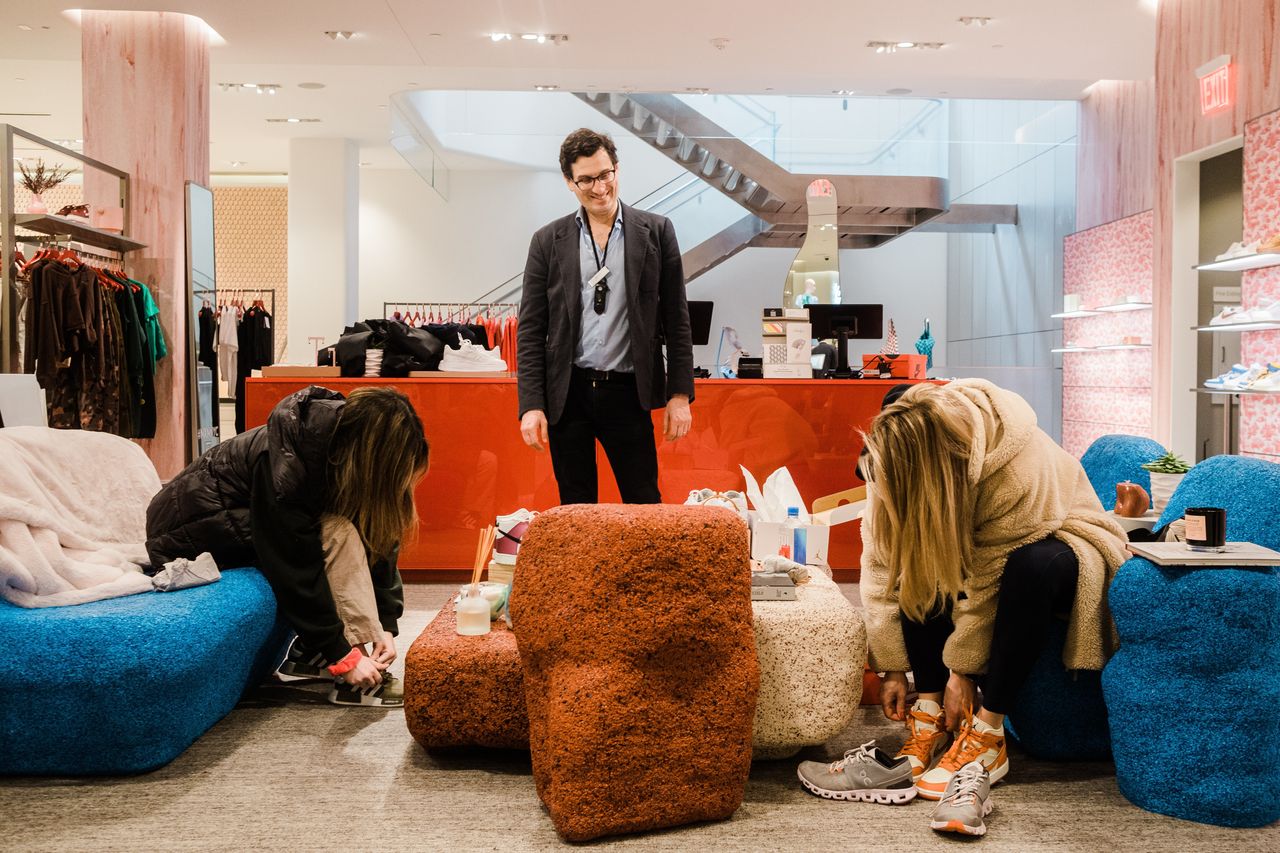That Style, Again? How Shopping Got So Boring
Manufacturers and retailers leaned on popular goods in the pandemic and often hit pause on innovating
The maker of Tonka trucks and Lite-Brite normally introduces four new toys a year. Last year, Basic Fun Inc. introduced one.
Manufacturers and retailers of everything from computers to dresses hit pause in the past few years when it came to innovation, the result of pandemic-related upheavals in the design, manufacture and distribution of goods, industry executives said. Shifting consumer demand and the expectation of an economic slowdown also played a role, the executives said.
New merchandise gives shoppers a reason to buy. Without it, sales tend to suffer. Retailers including Best Buy Co. and Gap Inc. said a dearth of new products, styles and colours contributed to lacklustre sales during the recent holiday season.
Now, the race is on to ramp up newness, the executives said. But the work that goes into creating new products often takes months, if not years. And some companies are reluctant to invest in the necessary research and development while economic uncertainty looms.
“The last thing you want to do is spend the money to create and market a new product and have it get stuck in the socio-economic crossfire of Covid, supply-chain disruptions and inflation,” said Basic Fun Chief Executive Jay Foreman. “All these things coming together at the same time means that you have to play it safe.”
Mr. Foreman said Basic Fun is delaying plans to relaunch its Littlest Pet Shop collectible figures until spring 2024 from fall of this year. “We anticipate the supply chain getting back to normal by the middle of this year,” he said. “But we’re still concerned about inflation and a slowdown in consumer spending.”
Gap Chairman and interim CEO Bob Martin said in an interview that a pile-up of excess inventory hindered the company’s ability to innovate.
“You stop leveraging creative strengths, you play it safe, and miss the bigger bets to get back on trend,” he said. Now that the company has worked through its excess inventory, he added, it has more room to devote to spring trends like eyelet and crochet tops at Gap, new suiting styles at Banana Republic, and Old Navy dresses with pockets.
There were 13% fewer new general merchandise items in 2022 compared with 2020, according to market-research firm Circana. The biggest declines were in beauty, footwear, technology, small appliances and toy categories.
Marshal Cohen, Circana’s chief industry adviser, said the decline is unprecedented and the result of several converging factors.
The Covid-19 pandemic radically altered consumption patterns, which forced manufacturers and retailers to pivot quickly to keep up with shifting demand. Supply-chain disruptions created first a scarcity of goods, and then a glut. With excess merchandise clogging shelves, retailers were unable to bring in fresh goods. Remote work made collaboration to dream up new ideas more difficult.
“Something as simple as a new flavour, colour or style can create demand,” Mr. Cohen said. “With a decline in newness, we are boring consumers to death.”
When demand for computers, TVs and other electronic gadgets surged, manufacturers focused on producing as much as they could of existing products to address shortages, Jason Bonfig, Best Buy’s chief merchandising officer, said in an interview.
Mr. Bonfig said he is starting to see an improvement in the flow of new products hitting stores, including TVs with larger screens and computers with longer battery life. “Vendors want to get back to growth,” he said. “They know new models are what brings people to our stores.”
Some retailers have acknowledged that the problem rests as much with them as with their suppliers.
“We didn’t have as many choices in women’s tops as we did in the past,” Ed Thomas, CEO of teen-clothing retailer Tilly’s Inc., said in an interview. “Part of that was our problem. We may have been offered styles that we said no to, because we were too gun-shy to take a chance. We had no idea where the economy was going, so we were more conservative in our buying.”
Nordstrom Inc. has set a goal this year of selling through its inventory at a rate 10% faster than last year, to allow it to bring in fresh merchandise more frequently, according to Pete Nordstrom, the department-store chain’s president. “We want our customers to say, ‘Every time I come to Nordstrom there is something new,’” he said.
Retailers said there are more new products hitting stores now that the supply chain is normalising and the excess inventory of past seasons has been cleared out.
But shoppers might not see a big change just yet.
“There is a disconnect between what’s in stores and what’s being shown on the runways and in fashion magazines,” said Lucia Gulbransen, a personal stylist. “You just can’t find the newness and the fashion-forward looks you see on Instagram.”
Some manufacturers said retailers are still too hesitant to pull the trigger on big, unproven bets.
“It’s an all-around risk-averse season,” said David Katz, chief marketing officer of Randa Apparel & Accessories, which makes clothing and accessories for brands ranging from Calvin Klein to Levi Strauss & Co. “There is more pushback than usual on new styles.”
Jackie Ferrari, CEO of clothing manufacturer American Fashion Network LLC, said basics such as T-shirts, tank tops and hoodies now account for about 60% of the assortment at large, mid tier chains, up from the low-50% range in 2019. Rather than adding new silhouettes, retailers are reordering best sellers with new colours and fabrics, she said.
The issue isn’t limited to companies selling consumer goods. Walt Disney Co. CEO Robert Iger recently told investors that the company needed to be careful about which comic-book characters and stories it develops into TV shows and movies from its Marvel Entertainment franchise to ensure “newness.” “Sequels typically work well for us,” Mr. Iger said. “Do you need a third or a fourth, for instance, or is it time to turn to other characters?”
Of course, there are always exceptions. Wide-leg jeans ushered in new clothing styles, including shorter tops and chunkier shoes, and luggage with built-in phone chargers spurred demand for new travel bags. But overall, retailers are still grappling with how to get more newness in front of shoppers, some of the executives said.
Customers are impatient. Robert Smith, a 49-year-old investment manager, said he started searching out smaller, more-unusual clothing brands online after showing up at a networking event wearing the same outfit as another attendee—a black linen shirt and matching shorts that he bought at a big-box chain.
“There isn’t much variety,” said Mr. Smith, who lives in Loves Park, Ill. “If you go to one store, you see the same thing at another store.”
 Copyright 2020, Dow Jones & Company, Inc. All Rights Reserved Worldwide. LEARN MORE
Copyright 2020, Dow Jones & Company, Inc. All Rights Reserved Worldwide. LEARN MORE
This stylish family home combines a classic palette and finishes with a flexible floorplan
Just 55 minutes from Sydney, make this your creative getaway located in the majestic Hawkesbury region.
Continued stagflation and cost of living pressures are causing couples to think twice about starting a family, new data has revealed, with long term impacts expected
Australia is in the midst of a ‘baby recession’ with preliminary estimates showing the number of births in 2023 fell by more than four percent to the lowest level since 2006, according to KPMG. The consultancy firm says this reflects the impact of cost-of-living pressures on the feasibility of younger Australians starting a family.
KPMG estimates that 289,100 babies were born in 2023. This compares to 300,684 babies in 2022 and 309,996 in 2021, according to the Australian Bureau of Statistics (ABS). KPMG urban economist Terry Rawnsley said weak economic growth often leads to a reduced number of births. In 2023, ABS data shows gross domestic product (GDP) fell to 1.5 percent. Despite the population growing by 2.5 percent in 2023, GDP on a per capita basis went into negative territory, down one percent over the 12 months.
“Birth rates provide insight into long-term population growth as well as the current confidence of Australian families,” said Mr Rawnsley. “We haven’t seen such a sharp drop in births in Australia since the period of economic stagflation in the 1970s, which coincided with the initial widespread adoption of the contraceptive pill.”
Mr Rawnsley said many Australian couples delayed starting a family while the pandemic played out in 2020. The number of births fell from 305,832 in 2019 to 294,369 in 2020. Then in 2021, strong employment and vast amounts of stimulus money, along with high household savings due to lockdowns, gave couples better financial means to have a baby. This led to a rebound in births.
However, the re-opening of the global economy in 2022 led to soaring inflation. By the start of 2023, the Australian consumer price index (CPI) had risen to its highest level since 1990 at 7.8 percent per annum. By that stage, the Reserve Bank had already commenced an aggressive rate-hiking strategy to fight inflation and had raised the cash rate every month between May and December 2022.
Five more rate hikes during 2023 put further pressure on couples with mortgages and put the brakes on family formation. “This combination of the pandemic and rapid economic changes explains the spike and subsequent sharp decline in birth rates we have observed over the past four years,” Mr Rawnsley said.
The impact of high costs of living on couples’ decision to have a baby is highlighted in births data for the capital cities. KPMG estimates there were 60,860 births in Sydney in 2023, down 8.6 percent from 2019. There were 56,270 births in Melbourne, down 7.3 percent. In Perth, there were 25,020 births, down 6 percent, while in Brisbane there were 30,250 births, down 4.3 percent. Canberra was the only capital city where there was no fall in the number of births in 2023 compared to 2019.
“CPI growth in Canberra has been slightly subdued compared to that in other major cities, and the economic outlook has remained strong,” Mr Rawnsley said. “This means families have not been hurting as much as those in other capital cities, and in turn, we’ve seen a stabilisation of births in the ACT.”
This stylish family home combines a classic palette and finishes with a flexible floorplan
Just 55 minutes from Sydney, make this your creative getaway located in the majestic Hawkesbury region.






















